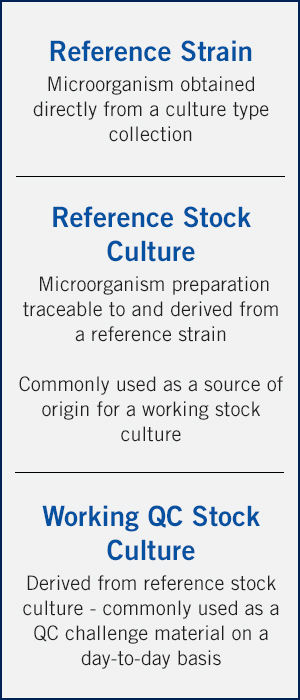 Are you certain the reference stock cultures you use for quality control are identical to the reference cultures you originally purchased?
Are you certain the reference stock cultures you use for quality control are identical to the reference cultures you originally purchased?
A study performed by Cross, Russel and Desai examined working cultures from eight accredited microbial testing laboratories. Using fluorescent amplified fragment length polymorphism (FAFLP) analysis, the study found some of the working cultures of Listeria monocytogenes and Staphylococcus aureus were genetically different from the original National Collection of Type Cultures (NCTC) strains. The cultures originally purchased from NCTC in England were frozen on cryobeads.1
What caused the genetic variation? Three possibilities are:
- Contamination
- Genetic drift due to repeated sub-culturing
- Genetic modification due to storage in a freezer too warm to adequately protect the microorganisms
The authors believe some of the cultures may have been contaminated with strains of Staphylococcus found on human skin. Genetic drift is also a possibility, but it is not known how often the cultures were subcultured. The authors learned, however, one of the eight laboratories had purchased the S. aureus strain eight to ten years earlier and three of the laboratories had no information about when the S. aureus strains were purchased.
One way for busy laboratories to decrease the risk of genetic variation and avoid contamination is to use reference stock cultures. Reputable commercial culture providers such as Microbiologics ensure the viability, stability and purity of the cultures. The laboratory is then only responsible for starting new cultures monthly and following the maintenance instructions provided by the supplier. Here are five other reasons outsourcing preservation of reference cultures is a smart move:
1. Regulators recommend using ultra-cold freezers
Bacteria stored for one year in a general-purpose freezer at -20˚C remain viable for about one year before ice crystals and chemical reactions within the cell cause damage.2,3 Several industry standards recommend microorganisms be stored in a cryoprotectant in an ultra-low freezer of -60˚C or colder because lower temperatures result in longer viability of the cell.
- The Clinical Laboratory Standards Institute (CLSI) says, “Some QC strains, particularly those with plasmid-mediated resistance, have been shown to lose the plasmid when stored at temperatures above -60˚C.”4
- ISO 11133 says, “Reference stocks should be stored in multiple portions, usually either deep-frozen, e.g. below -70˚C, or lyophilized. At a higher temperature, duration of viability might be reduced and genetic modification might occur.”5
- The Personal Care Products Council (PCPC) Laboratory Manual says a deep-freezing method of -70˚C to -130˚C, “provides for superior culture viability in comparison to what can be obtained by ordinary freezing.”6
Laboratories using commercial cultures don’t need to use an expensive ultra-cold freezer to store their reference stock cultures, and they never need to worry about cultures being lost if power fails or frozen cultures are accidently left out overnight on a counter. Plus, fewer supplies are required. The list below compares the supplies required for maintaining frozen cultures versus using Microbiologics ready-to-use cultures.
| Maintaining Cultures by Freezing | Using Microbiologics Cultures |
| -80˚C freezer | Refrigerator (2˚C – 8˚C) |
| Freezer alarm | Agar |
| Back-up system in case of electric failure | |
| Cryobeads | |
| Agar | |
| Labels |
2. Maintaining stock cultures is time consuming and increases chances for error
When commercial cultures are used, personnel in the laboratory do not have to spend valuable time:
- Freezing cultures
- Labeling cultures
- Thawing cultures
- Verifying morphological characteristics and purity after growing the thawed culture
In addition to saving time, mix-ups and errors can be avoided by eliminating freezing. Potential problems of freezing include:
- Refreezing cryobeads after they have partially thawed (repeated freeze-thaw cycles may compromise the genetic integrity of the organisms) 7
- Mislabeling tubes
- Spilling or contaminating cryobeads
- Misplacing and losing tubes in the freezer
- Dead cultures
Comparison Between Maintenance Methods
| Freezing at 0˚C to -20˚C | Freezing at -70˚C with Cryoprotectant | Using Microbiologics Cultures and Maintenance Plan |
| Inexpensive
Poor culture viability Temperature cycling may cause ongoing cell damage |
Cultures may last for several years
Expensive: Ultra low freezer, cryoprotectant required Freezer alarm and back-up system needed if power fails |
Time saver
Lyophilized pellets can be stored in the refrigerator Limited subcultures reduces the risk of genetic variation Traceability to original culture provides assurance to the laboratory Knowledgeable and friendly technical support is available |
3. Culture purity and identification could be jeopardized
Obtaining commercial cultures from a reliable source means a laboratory doesn’t have to second-guess a strain’s purity and identification. Microbiologics ensures microorganisms are not contaminated by checking the identity and confirming the purity of each lot produced using tests and techniques that have been accredited under its ISO 17025 Scope. Microbiologics recommends users maintain their cultures for no more than one month, so there is less opportunity for a culture to become contaminated.
Microbiologics verifies the physiological characteristics of a strain remains stable during the preservation process by running proteolytic, phenotypic and/or susceptibility tests before and after lyophilization.
4. Excessive subcultures increase the risk of mutation
By using Microbiologics cultures and following its plan for maintaining cultures for one month, laboratories can limit the number of passages from the reference stock culture. According to the United States Pharmacopeia (USP), excessive subculturing can increase the risk of phenotypic alteration or mutation.
Several industry standards recommend discarding working stock cultures after one month:
- ISO 11133 says cultures can be stored on agar at a suitable temperature for up to four weeks.
- CLSI recommends maintaining strains used in antimicrobial susceptibility tests for no more than a month on agar. CLSI cautions some antibiotic resistant strains should only be maintained on agar for two weeks because these strains can easily lose the plasmid containing the antimicrobial properties.8
5. No support when times get tough
- Microbiologics issues Certificates of Analysis for every lot it produces. On the certificate, you can see where Microbiologics originally purchased the stock culture and what biochemical and phenotypic tests were performed on the microorganism strain. If an auditor asks about a culture’s traceability to reference culture, just show them the certificate.
- Experienced microbiologists on the Technical Support team are available to help you if you have a question or a problem.
Microbiologics offers over 900 strains in a variety of easy-to-use formats. Visit our website to learn more.
References
1Cross, L.J., Russell J.E., and Desai, M. Examining the genetic variation of reference microbial cultures used within food and environmental laboratories using fluorescent amplified fragment length polymorphism analysis. FEMS Microbiology Letters. Volume 321, Issue 2. August 2011.
2OPS DIAGNOSTICS: A Guide to Bacteria Preservation: Refrigeration, Freezing and Freeze Drying. https://opsdiagnostics.com/notes/ranpri/aguidetobacteriapreservation.htm
3Petti, C. A. and Carroll, K.C. Procedures for the Storage of Microorganisms. In: Manual of Clinical Microbiology 10th Edition (pp. 124-131). Versalovic, J., Carroll, K.C., Funke, G., Jorgenson, J.H., Landry, M.L., Warnock, D.W. (Eds.) ASM Press, Washington, DC. 2011.
4Clinical Laboratories Standard Institute, MO2-A12, Performance Standards for Antimicrobial Disk Susceptibility Tests. Approved Standard 12th Edition. Jan 2012.
5ISO 11133. Microbiology of food, animal feed and water – Preparation, production, storage and performance testing of culture media. www.iso.org.
6Personal Care Products Council Microbiology Guidelines. Maintenance and Preservation of Test Organisms. 2016
7Smith, D. and Ryan, M. Implementing Best Practices and Validation of Cryopreservation Techniques for Microorganisms. The Scientific World Journal, Volume 2012, Article ID 805659. 2012






Very nice and helpful topic to me thanks a lot sir
Are you able to supply and maintain cultures of Enterococcus faecium strain NRRL B 2354 ATCC 8459 required for valuation test purposes for the destruction of Salmonella sp. in heat drying processing?
Kevin – Thanks for asking about the strain. We have had a few requests for this strain and are considering adding it to our collection. If you have further questions, please reach out to our Technical Support team at techsupport@microbiologics.com or +1.320.229.7045.
Can working stock cultures be safely kept longer than one month if stored on an agar slant covered in sterile mineral oil?
Kelly – We don’t recommend using this method to extend the life of a stock culture. Instead, we recommend following our Maintenance of Quality Control Strains document to ensure viability, purity, and genotypic/phenotypic characteristics for our microorganism strains. You can find the document here. If you have further questions, please reach out to our Technical Support team at techsupport@microbiologics.com or +1.320.229.7045.
Wouldn’t this effect any research of those labs if they published papers on some of the bacteria that has shown genetic change or contamination?
Proper maintenance of a strain is essential for ensuring acceptable performance. If the stock culture has mutated or has been contaminated, performance of the stock may be affected which could influence the results.
Nice and helpful blog.
I am planning to shift my laboratary to a new location. I am planning to seek help from firm in Mississauga(https://www.armstrongscientifictransport.com/our-services/lab-relocation/
) Can you mention the steps that I should take care while shifting it? What about using custom crating for the same?
Nicki – Because it is not our specialty, we cannot offer advice on the logistics of laboratory relocation. However, if you are transporting any of our products, they should be kept under refrigeration (at 2-8°C) during that process.
conditions necessary for the maintenance of different culture
Hi Immanuel, thank you for reaching out! If you choose to maintain your environmental isolates using stock culture plans, please see our Maintenance of Quality Control Strains Technical Information Bulletin for recommendations. The file can be downloaded here: https://www.microbiologics.com/Maintenance-of-Quality-Control-Strains